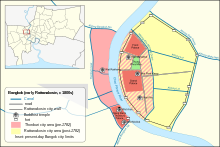
The Thonburi city moat (Thai: คลองคูเมืองธนบุรีฝั่งตะวันตก) is the collective name of many several waterways in the form of moats on the Thonburi side or the west bank of the Chao Phraya river, location of Thonburi Kingdom, the former capital of Thailand between the years 1767 to 1782 ruled by a single monarch, King Taksin.
These moats were part of the city moat of Thonburi Kingdom. They were canalized from the natural water-furrows surrounded by the fruit orchards and green space that flow through the west bank of the Chao Phraya river, by order of King Taksin in 1771, as a fortress to protect the new capital, Thonburi, after the fall of Ayutthaya in 1767. Currently, they occupy two consecutive districts of Bangkok—Bangkok Yai and Bangkok Noi.
Some parts were also extend to the east bank of the Chao Phraya river, now known as Khlong Rop Krung and Khlong Khu Mueang Doem, they formed Rattanakosin Island.
The moats were was called separately the name by the quarters that they passed through. Their origins were at the mouth of the Khlong Bangkok Yai next to the Wichai Prasit Fort (previously Bangkok Fort or Wichayen Fort), turn north up till it ends at the mouth of Khlong Bangkok Noi near the present-day Siriraj Hospital and Siriraj Bimuksthan Museum (former site of Bangkok Noi railway station).
Each of the moats was named, and are as follows, from south to north, they are:
- Khlong Wat Tai Talat, near what are now Wat Molilokkayaram and Khlong Wat Arun
- Khlong Ban Mo, near what are now Royal Thai Navy Convention Hall and Taweethapisek School, total length 2.56 km (1.6 mi). Its name comes from the fact that it used to be a settlement of the Mon who made and sold pottery just like the Ban Mo area on Rattanakosin Island
- Khlong Ban Khamin, near what is the area called Ban Khamin and the location of Thonburi Hospital, total length 1.59 km (1.0 mi). It was once an area where turmeric was grown and processed into powder for use as a traditional medicine and as a cosmetic for skin care. It is said that in those days both sides of the moat were perfumed with the scent of turmeric
- Khlong Ban Chang Lo, in the area of Ban Chang Lo to Siriraj Hospital, it is cut across by Khlong Wat Rakhang
- Khlong Ban Noen, near what is the area called Ban Noen, near Bangkok Noi railway station (now Thon Buri railway station) and the northern end of Itsaraphap road
The distance between Khlong Wat Tai Talat and Khlong Ban Mo, there is another waterway that cuts through it, Khlong Wat Arun or Khlong Wat Jaeng, officially Khlong Nakhon Ban. It lies to the north of Wat Arun or internationally Temple of Dawn. During the Thonburi period, the location of Wat Arun was annexed to the area of the Thonburi Palace, so this small canal was then the north moat of the Thonburi Palace, the resident of King Taksin. It is a tributary of the Chao Phraya river, which parts from the Chao Phraya to join with Khlong Mon at the side of the temple, total length 1.45 km (0.9 mi). Currently, an extension of Arun Amarin road spans through it.
In the past, the water in the moats were clear and clean and could be used for consumption. Including being a transportation route, and was also a habitat for various types of edible fish, as well as giant freshwater prawns, the local delicacy. What is a pity that at present, the moats are shallow and polluted. This is the result of filling in for roads and railways included building concrete banks on both sides of them. As a result, these moats no longer remain as fortresses and historical landmarks as they were in the past.
See also
Notes
- A name was changed during King Taksin's reign. Originally double fortresses located on opposite sides of the Chao Phraya river, they were built in the medieval Ayutthaya before King Narai's reign of Prasat Thong dynasty. The forts were renovated and promoted to a major fortress by Greek expatriate noble Constantine Phaulkon, and were also controlled by French and Portuguese mercenaries due to Bangkok at that time had the status of an outpost. Later, the fort on the east side of the Chao Phraya or known today Phra Nakhon side (Bangkok core), was dismantled during King Phetracha's reign of Ban Phlu Luang dynasty after the event Siege of Bangkok (1688).
References
- ^ JakRakSuRao (2022-02-21). "คลองบ้านขมิ้น : เที่ยวคูเมืองธนบุรี ดูของดีฝั่งธนฯ". Thai PBS (in Thai). Retrieved 2024-03-04.
- ^ Pinijnakhon (2009-02-09). "พินิจนคร (Season 1) ตอน ธนบุรี 1". Thai PBS (in Thai). Retrieved 2024-03-05.
- ^ Chaikong, Phanuphong (2016-04-26). "คลองคูเมืองธนบุรีฝั่งตะวันตก เหลือฐานะแค่" ท่อระบายน้ำ "". Lek-Prapai Viriyapan Foundation (in Thai). Retrieved 2024-03-04.
- ^ "กทม.เล็งฟื้นฟูคลองคูเมืองธนบุรีฝั่งตะวันตก ขุดสมัยพระเจ้าตาก". Prachachat Turakij (in Thai). 2021-09-14. Retrieved 2024-03-04.
- JakRakSuRao (2022-01-24). "บ้านหม้อ : เชื้อชาติ ร่องรอย หลากหลาย". Thai PBS (in Thai). Retrieved 2024-03-04.
- สร้างประวัติศาสตร์สังคมย่านเมืองเก่ากรุงเทพฯ (2016-11-03). "แผนที่เมืองธนบุรี". Facebook (in Thai). Retrieved 2024-03-04.
13°45′09″N 100°29′00″E / 13.752413°N 100.483371°E / 13.752413; 100.483371
Categories: